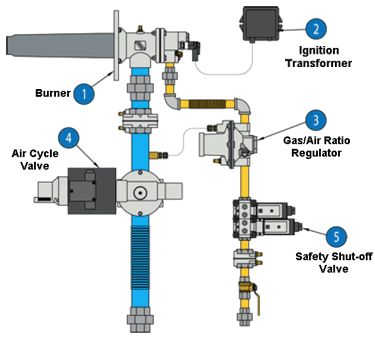Improve your bottom line, lower your operating costs, increase your product quality, and do your part to reduce greenhouse gases. How? By using pulse-fire to transform your industrial furnace!
What is Pulse-fire?
More than anything else, pulse-fire is a method of introducing heat into a gas-fired furnace. Traditional modulating systems use valves to control the range of heat; the burners are always firing, at greater or lesser intensities. A pulse-fire system is fundamentally different, as the burners are not fired constantly, but instead “pulsed” in an on/off or high-fire/low-fire pattern.
Pulse-fire History
The pulse-fire concept was developed in Germany more than 30 years ago. The principal was simple, inspired by the philosophy that firing a burner on/off or high/low would promote better temperature uniformity and energy efficiency.
However, there were difficulties with the early implementation, as the equipment requirements exceeded what was available at the time. These requirements include, but are not limited to, the operating cycles of the air and gas valves.
The availability of suitable components has greatly improved over the years, though the industry in North America has been slow to adopt pulse-fire technology. The most common combustion control design is still the cross-connected ratio system.
Pulse-fire Advantages
Pulse-fire systems are easy to install and boast up to 30% fuel savings with greatly reduced commissioning times. Once in operation, many users enjoy the flexibility of firing patterns and burner on-times, in addition to the ease with which pulse-fire furnaces can be re-zoned – no piping changes are required.
Pulsing the burners in a system greatly increases the turbulence inside the furnace, which increases convective heat transfer. The result is faster heating times, and greater product saturation. Since pulse-fire operates burners at a single operating point (high fire), the proper air/gas ratio is much easier to maintain and burner maintenance is greatly simplified – since burners are individually controlled, they can be individually tuned.
Many of these factors: improved temperature uniformity, greater control flexibility and on-ratio turndown, and optimized air/gas ratio, combine to result in significantly increased productivity and fuel savings, along with a reduction in air pollution.
NEXT: Pulse-fire Equipment
Not all combustion equipment is suitable for pulse-firing. Some of the key equipment requirements for a successful pulse-fire installation include: operating cycles in excess of one million, capability of three cycles per minute, and repeatability.
Stay tuned for our next blog post to learn more.




2 Comments